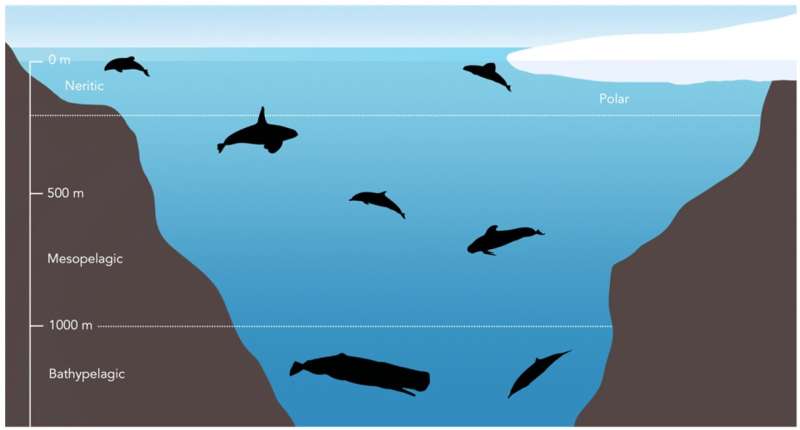Locations for 21 species of cetaceans (denoted by shape and color) sampled in New Zealand between 2010 and 2021. Sample size for each species is denoted in parentheses. Bathymetry is depicted with darker shades of blue representing deeper waters. Credit: National Institute of Water and Atmospheric Research (NIWA) under a CC BY license, with permission from NIWA original copyright [33]
An international collaborative study involving researchers from Massey University, the University of Canterbury, NIWA, and Flinders University has analyzed the isotopic niche of 21 species of toothed whales in New Zealand.
Results show that some species have a clear niche separation, while others overlap substantially.
The study, published this week in the international journal Biology, details almost no overlap in niche space between sperm whales and Gray's beaked whales, which are both species foraging in deep waters. However, for species foraging in coastal waters or the open ocean, competition may be fierce, with species in these habitats overlapping substantially with each other in their foraging niche.
Research lead Dr. Katharina Peters of the University of Canterbury says, "Animals often go to great length to avoid competition and enable coexistence. When there is a large overlap in foraging niche, it is possible that they avoid competition in other ways, for example, foraging during different times of the day."
New Zealand is home to an extraordinarily rich marine fauna, including 50% of the world's whale and dolphin species. This rich abundance almost guarantees that some species are competing for their dinner. Study co-author Professor Karen Stockin, who leads the Cetacean Ecology Research Group at Massey University, says, "We have been studying these animals for more than 20 years but still there is so much we don't understand about their feeding ecology. Stable isotopes collected from stranded animals [have] now offered us first insights to the trophic levels at which these complex mammals feed and compete."
Habitat zones in which exemplar odontocete species are grouped. Note that not all species included in the study are shown here. Credit: Katharina J. Peters et al, Biology (2022). DOI: 10.3390/biology11081179
Whales and dolphins play a crucial part in maintaining ecosystem health and functioning; thus knowing about their foraging ecology is key to understanding how the ecosystem will adapt to future changes such as ocean warming fishery pressures causing changes to prey abundance and distributions.
"We need to know more about the mechanisms that allow these species to coexist in New Zealand waters," says Dr. Peters, "This is particularly important for species endemic to New Zealand, such as Hector's dolphins. We are already aware that their habitat is changing, but we don't know how this will impact the species."
More information: Katharina J. Peters et al, Too Close for Comfort? Isotopic Niche Segregation in New Zealand's Odontocetes, Biology (2022). DOI: 10.3390/biology11081179
Provided by University of Canterbury
![Locations for 21 species of cetaceans (denoted by shape and color) sampled in New Zealand between 2010 and 2021. Sample size for each species is denoted in parentheses. Bathymetry is depicted with darker shades of blue representing deeper waters. Credit: National Institute of Water and Atmospheric Research (NIWA) under a CC BY license, with permission from NIWA original copyright [33] New research using stable isotopes sheds light on how New Zealand’s diverse range of toothed whales and dolphins coexist](https://scx1.b-cdn.net/csz/news/800a/2022/new-research-using-sta.jpg)
























